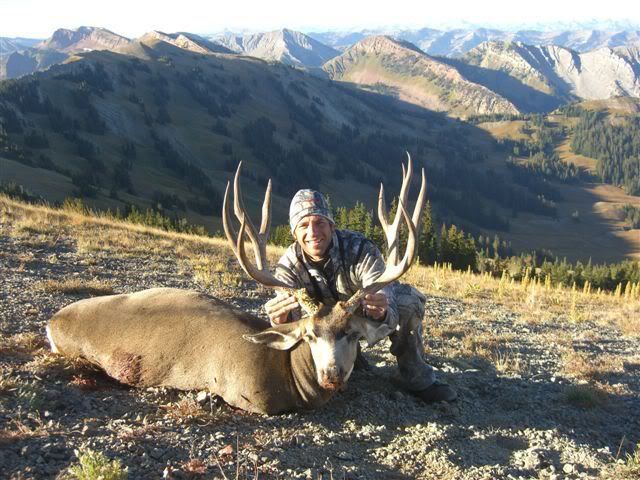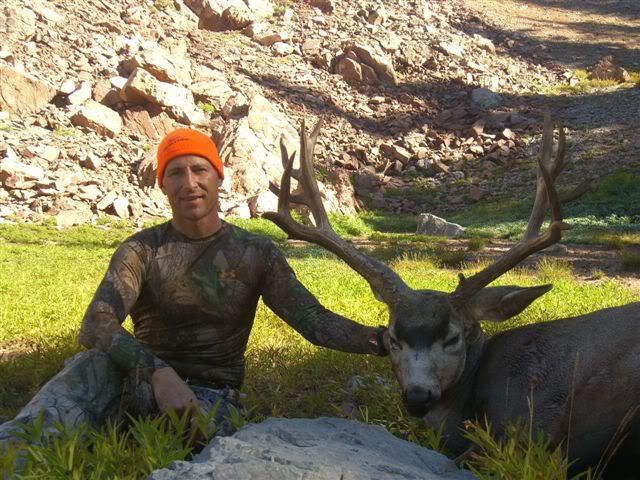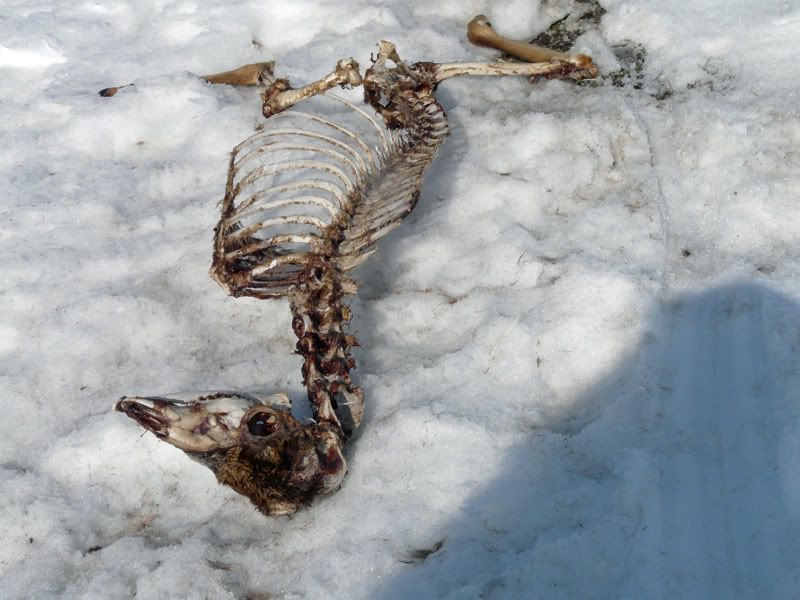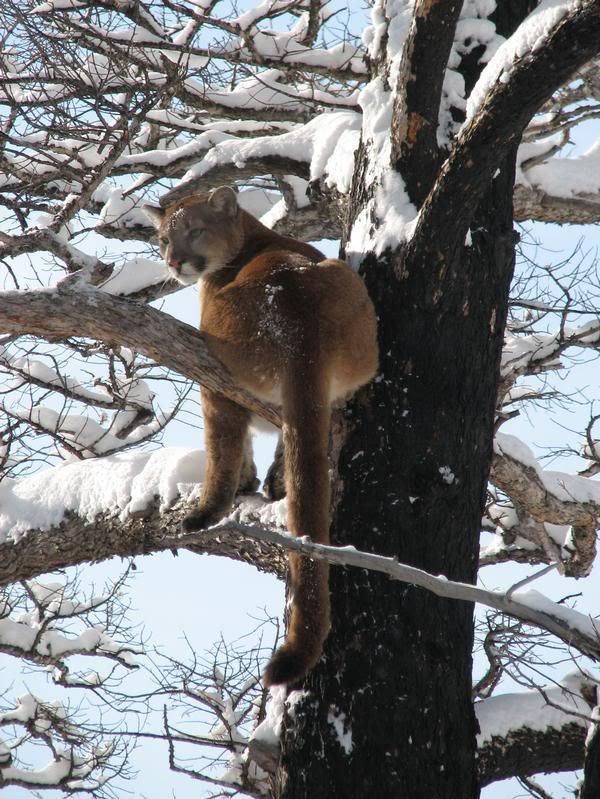Two Wyoming hunters and their bucks:



Some sources are reporting heavy winter mortality in Western Wyoming mule deer herds. With wolves moving into that area, who knows if the cause is snow or big puppies.
The hunting community, via certain organizations – like the Mule Deer Foundation, is up in arms about the BLM leasing rights to oil drilling companies. Such parties are claiming that the deer herd has diminished by half since the drilling started.
If, indeed harsh winters are killing large numbers of mule deer, the loss may have nothing to do with drilling, but may be purely coincidental to drilling.
A fact that is going unmentioned here is that wolves and grizzlies are increasing their presence in the area in a big way. Both drilling and harsh winters may only be scapegoats.

Two different reports, one in May and one in June indicate a high winter mortality amongst Mule Deer in South Western Wyoming:
—————————————
Associated Press – May 26, 2008 4:45 PM ET
GREEN RIVER, Wyo. (AP) – A mortality survey of Wyoming’s largest mule deer herd indicates that the harsh winter took a toll on the animals.
The annual mortality surveys for the Wyoming Range mule deer herd were conducted this spring near Cokeville, Pinedale and Big Piney and near Leroy in the Bridger Valley.
Wyoming Game and Fish Department biologists and others counted 313 dead mule deer during the Cokeville, Pinedale and Big Piney surveys.
Officials said an additional 340 dead mule deer were found on the Leroy survey in Uinta County, for a total of 653 dead deer.
Game officials noted an unusually high number of adult deer deaths.
Information from: Star-Tribune, http://www.casperstartribune.net
Parts of deer herd hit hard by rough winter
Deaths high around Cokeville, but Pinedale, Daniel fared well.
By Cory Hatch Jackson Hole, Wyoming
June 4, 2008A harsh winter and poor forage led to a high number of mule deer deaths for portions of the Wyoming Range herd, including some animals that summer near Jackson.
Gary Fralick, a wildlife biologist for the Wyoming Game and Fish Department, said volunteers counted 313 dead mule deer in the Cokeville area, most of which succumbed to starvation or other effects of winter. Thirty-eight percent of the animals were adult and 58 percent were fawns. An additional 340 winter-killed mule deer were found in the Leroy area.
The relatively high percentage of adult deaths compared with fawns is typical during a harsh winter, Fralick said.
“We had severe snow accumulations and extreme temperatures,” he said. The plants deer feed on “are just in poor shape and are not able to sustain these herds over the hard winter because of drought and because [they] are getting old and decadent,” he said. “On that particular winter range, every three years you can pretty much count on a winter that will take a significant portion of that population.”
Fralick said relatively low winter mortality for portions of the herd in the Pinedale, Big Piney and Daniel areas likely compensated for the hit on the population. Winter mortality for the entire herd likely ranged from 5 percent to 15 percent, he said.
“What that means is the other segment of the deer on the winter range came out in outstanding condition,” Fralick said. “There was good winter survival [in Daniel and Big Piney and the Pinedale Mesa] those deer came through the winter in pretty good shape.”
The mule deer herd is the largest in Wyoming, stretching from Interstate 80 to the Snake River Canyon, and in the past has ranged from 20,000 to 50,000 animals.
During a two-year radio-collar study that started in 1990, Fralick said, researchers documented deer from the Cokeville area that migrated to summer ranges in the Greys River Range, the Grayback Ridge area, the Snake River Canyon and into Hoback Basin.
“There’s major movement off of those winter ranges,” he said. “These deer are migrating from winter to summer range 180 to 200 miles.”
Fralick said the high mortality last winter could mean fewer deer going back to summer range in places like the Smiths Fork, Commissary Ridge and the south end of the Salt Range.
Fralick said hunting seasons this year are already set, and most of those seasons’ limits are already conservative. But he said this year’s winter kill could affect hunters in a couple of years.
“That’s going to translate into fewer 2-year-old bucks in two years,” he said.
Heavy rain and snow this winter and spring could help restore forage in the Cokeville area, but Fralick said it’s too late for some of the plants.
“A lot of the browse plans have been dying over the past five years,” he said. “The ones that are still alive it’s going to benefit, but the trend has been toward dead and decadent on these browse plants.”
Fralick said other factors also take a toll, including human land use, drought and especially motor vehicle collisions.
“We lose 200 to 600 or more deer every year on Wyoming Range highways,” he said.
Bob Wharff, executive director of the Wyoming chapter of the Sportsmen for Fish and Wildlife, criticized the Wyoming Game and Fish Department for not initiating emergency feeding for mule deer populations that were hard hit this winter.
———————–
Comment:
“I’m mad that Game and Fish didn’t feed the deer,” he said. “They have told us numerous times that if the conditions got bad that they would institute an emergency feeding program. It makes no sense to me to not take care of that population. I do think we’re morally obligated to do that.

Trophy wolf hunting set for Oct. 1
Posted: Wednesday, May 28th, 2008
BY: Joy Ufford
G&F sets limit at 25 wolves for 4 hunt areas
A total “harvest quota” of 25 trophy-game gray wolves, in a hunting season suggested to open Oct. 1 this year in northwest Wyoming, is a new element in this year’s Wyoming Game and Fish (G&F) annual release of proposed hunting season changes.
“The structure of the season will be an Area Harvest Quota Limitation, in which the season for each wolf hunt area will close when the harvest quota for that area has been reached,” said G&F spokesman Eric Keszler. “The proposal will establish wolf seasons and harvest quotas in four hunt areas in the Trophy Game Area of northwest Wyoming.”
A harvest quota is defined in the new regulation draft as “the total number of gray wolves for a single hunt area that may be legally taken by licensed hunters during any single gray wolf hunting season within the area where gray wolves are classified as trophy game animals.”
General licenses will cost $15 for Wyoming hunters, $150 for nonresident hunters.
Four hunt areas
The four new hunt areas are drawn from the designated trophy-game area with exceptions for national park lands. (See Wyoming Game and Fish map.)
The Green River and Gros Ventre Hunt Areas each have a harvest quota of five animals taken with an Oct. 1 opening date and closing on Nov. 30 and Nov. 15, respectively, or when the quotas are reached. The Sunlight (five wolves) and Francs Peak (10 wolves) Hunt Areas would also open Oct. 1 and run through Nov. 30 or until the quotas are filled.
The Gros Ventre Hunt Area (HA 3) begins at the junction of Highway 26/287 with Union Pass Road then follows south along Forest Service Road 600 and the Bridger-Teton National Forest boundary to Highway 189/191 where it follows the highway northwest through Bondurant to Hoback Junction, up to Highway 22 in Jackson and along Highway 22 through Wilson to the Idaho line and zigzags around Grand Teton Park and John D. Memorial Parkway. It excludes all lands within Teton Park and the National Elk Refuge.
The Green River Hunt Area (HA 4) begins where Highway 26/287 crosses the west boundary of the Wind River Reservation, south to the Continental Divide then southeast along the Divide to go west along the Middle Fork of Boulder Creek to the BTNF boundary and northwesterly to Union Pass Road.
The Sunlight Hunt Area (HA 1) begins at the junction of Highway 120 at the Montana state line, runs south to the intersection with Highway 14/16/20 in Cody, then west to Yellowstone and along the park boundary to the state line and back to Highway 120.
The Francs Peak Hunt Area (HA 2) begins at the intersection of Highway 120 and Highway 14/16/20 in Cody, runs south along the highway to the Greybull River, southwest along the river to the Shoshone national Forest, south along that boundary to the Wind River Reservation and west and south to where it meets Highway 26/287, then to the east boundary of the John D. Memorial Parkway and up along Yellowstone’s east boundary to meet back at highway 120 in Cody.
Draft rules
Draft regulations state a hunter must confirm whether or not a hunt area’s quota is met before hunting there. Only legal firearms and archery equipment can be used; it is illegal to use radio-tracking equipment to take a trophy wolf, the new regulations say.
The bag and possession limit for licensed hunters will be one wolf during the calendar year and that can be any gray wolf in the applicable hunt area.
Hunters must report taking a trophy wolf within 24 hours by calling (866) 373-5805 any time of day or night. They also must retain the skull and unfrozen pelt, with visible evidence of sex attached naturally, and present them to a district game warden, district wildlife biologist or G&F personnel at a regional office within five days for collection of biological samples. Radio-tracking devices such as electronic collars or ear tags must be surrendered to the G&F as well.
Conservative start
G&F Wildlife Assistant Chief Bill Rudd said last week the proposed wolf hunting season and harvest quota are “an extremely conservative approach to wolf hunting in Wyoming.”
U.S. Fish and Wildlife Services (FWS) Wolf Recovery Coordinator Ed Bangs, who led the recovery project to the gray wolf’s March delisting, agreed this week.
“I think the WGFD recommendation of 25 tags as a start is a good one,” he said.
Bangs said he expects most prospective Wyoming wolf hunters will buy tags to go along with another big-game hunt.
“Most hunters won’t ever hunt for wolves but take them while hunting something else,” he said. “Same thing here – it will be elk and deer hunters that harvest wolves during the fall big game season.”
The Idaho Fish and Game Commission met last week and chose to allow higher hunting quotas to take Idaho’s wolf population back to its 2005 population level.
Bangs said, “…In Idaho the (Fish and Game) Commission ignored the IDFG recommendations and passed the maximum wolf kill under wolf-hater pressure, to get the wolf population down to the lowest level in their management plan (but still 518 wolves) – so we’ll see how good (G&F) is at ‘wolf’ politics.”
The IFGC set a wolf population goal of 518 wolves and adopted seasons, limits and rules for this year.
The Idaho Wolf Population Management Plan, approved in early March, calls for managing wolves at a population level of between 2005-2007 levels (518 to 732) wolves for the first five years after delisting. With an annual estimated growth rate of 20 to 30 percent, Idaho’s population could exceed 1,000 wolves before the state’s new hunting seasons open, Sept. 15 and Oct. 1. Idaho hunt areas will be open through Dec. 31 with possible season extensions if quotas aren’t met.
In Wyoming wolves are increasing at about 24 percent annually, said Rudd.
“Wolves… in Wyoming and can sustain much higher harvest than we are proposing through hunting,” he said. “Removing some wolves through controlled hunting can also help prevent wolf-livestock conflicts in some cases.”
More information
The proposed wolf hunting season, hunt areas and regulations are included in G&F’s “Chapter 47: Gray Wolf Hunting Seasons.” To see proposed wolf hunting seasons and associated information, visit http://gf.state.wy.us/services/education/wolves/index.asp.
A public comment period on this proposal as well as other G&F hunting issues is open through 5 p.m. on July 3. The G&F Commission will take actions on the proposed trophy wolf season and other hunting issues when it meets in Dubois, July 30-Aug. 1.
Public meetings are planned across Wyoming but mainly in the western part of the state for discussion and comments on the wolf season and other 2008 hunting issues including mountain lion seasons, furbearing and trapping seasons, taxidermy regulation and issuance of licenses, special points and interstate game tags.
G&F will hold the Pinedale meeting June 10 at 7 p.m., at the Pinedale Library. On June 11, a meeting will be held at 7 p.m. at the Antler Inn. Other meetings are set for Green River (June 9), Laramie (June 9), Lander (June 10), Sheridan (June 11), Cody (June 12) and Casper (June 12).
Copies of all regulation changes and seasons can be viewed at the public meetings or by contacting the Casper Game and Fish office at (307) 473-3400. All comments must be in writing and must be submitted at the public meetings or mailed to: Wyoming Game and Fish Department, Wildlife Division, ATTN: Regulations, 3030 Energy Lane, Casper, WY 82604.

Reports from Southwestern Wyoming are that there has been a heavy winter mortality ( due to deep snow and extreme cold ) for the mule deer that migrate to the south (Red Desert). In contrast, apparently, deer that wintered in the area of all the oil wells ( Green River Basin ) came through the winter in good shape.
This area is home to Wyoming’s largest Mule Deer herd, and indeed, one of the largest in the world. Some sportsmen organizations are beating up on the WGnF for not feeding the mule deer. Personally, I support the WGnF in not feeding the deer, however, I think late hunts provide an alternative to letting deer starve or die to exposure.
There are now a growing number of wolves in SW Wyoming. So far, wolves have not impacted mule deer significantly on summer range, but unless some action is taken, the big doggies will soon be having a significant impact on the mule deer winter ranges.
Wyoming is now spending some money to create deer underpasses on the highway south of Cokeville, where it is believed that some 15,000 mule deer migrate between summer and winter ranges. This migration, in some cases – as long as 100 miles, may be the longest for mule deer, anywhere.
 For the hunter, it is already getting harder to draw a tag in Region G, due to last year’s addition of bonus points. Now, Wyoming will likely reduce the number of tags as well. Preliminary data indicates that the older bucks were not impacted as much as expected. A high percentage of the die-off was fawns, which will impact the number of mature bucks beginning in 2010.
For the hunter, it is already getting harder to draw a tag in Region G, due to last year’s addition of bonus points. Now, Wyoming will likely reduce the number of tags as well. Preliminary data indicates that the older bucks were not impacted as much as expected. A high percentage of the die-off was fawns, which will impact the number of mature bucks beginning in 2010.

This Wyoming Rancher didn’t waste any time dealing with a problem:
—————————
This morning about 7:00 we were eating breakfast and Lora suddenly yelled “There’s a wolf in the yard!” Well, the next few seconds went pretty quick. I grabbed a rifle and cracked the door and stuck the muzzle out the door and bang we had one less wolf. Black male and weighed 93 pounds. Got him skinned and will plan to get the hide tanned. So that was the excitement for today.
Notice the difference in size

Last year there was a bill in front of the Wyoming legislature to allow carrying a gun during bow season. This is an interesting proposition. If any of you have heard the outcome, please let us know and we will post it for our subscribers.
Thanks, and May the Force be with You
Admin

It’s too late to apply for a Wyoming Mule Deer Hunt, but you can still apply for a “brownie point”.
——————————————
“The Department shall allocate not less than seventy-five percent (75%) of the available nonresident Elk, Deer and Antelope licenses to a preference point drawing and twenty-five percent (25%) of the available nonresident Elk, Deer and Antelope licenses will be assigned to a random drawing in which all unsuccessful applicants from the preference point drawing shall be placed.
For party applications, the number of preference points for each applicant within the party will be averaged for the preference point ranking to be used for the ranking in the preference point drawing.
Purchasing ONLY A PREFERENCE POINT can ONLY OCCUR from July 1, 2008 through September 30, 2008. DO NOT ATTEMPT TO PURCHASE A PREFERENCE POINT ONLY during any of the initial license application periods. YOU MUST WAIT until July 1st to purchase only a Preference Point. The price is $50.00 for Elk, $40.00 for Deer and $30.00 for Antelope ($10.00 for youth for each species). There is NO APPLICATION FEE TO PURCHASE A PREFERENCE POINT ONLY.
REMEMBER, a PREFERENCE POINT ONLY PURCHASE is DIFFERENT THAN an application for a license with a PREFERENCE POINT OPTION. THE PREFERENCE POINT OPTION takes place during the initial license application periods. If you elect this OPTION when applying for an Elk, Deer or Antelope license, the fee, which you must remit with your application for a regular elk license, is $641.00 ($14.00 application fee, $577.00 license fee and $50.00 preference point fee). Regular deer license is $366.00 ($14.00 application fee, $312.00 license fee and $40.00 preference point fee). Regular antelope license is $316.00 ($14.00 application fee, 272.00 license fee and $30.00 preference point fee).
To purchase a Preference Point, an applicant must be at least eleven (11) years old at the time of application and be at least twelve (12) years old by December 31 of the year of application.
An applicant may fail to apply for a license or fail to purchase a Preference Point for one (1) year without losing accumulated Preference Points. However, if an applicant fails to properly apply for a license or purchase a Preference Point for two consecutive years, the accumulated Preference Points will be deleted.
The Preference Point system is designed to award a point for each unsuccessful draw attempt in a hard to draw area for individuals who elect the PREFERENCE POINT OPTION and remit the additional Preference Point fees, yet not penalize those who wish to list an easier to draw area on their second or third choice. If a person draws on the second or third choice when electing the PREFERENCE POINT OPTION, a Preference Point will be awarded even though a license is issued. If the person is successful in drawing his or her first choice, then all Preference Points are deleted but the preference point fee paid for that year is refunded. DRAWING A SECOND OR THIRD CHOICE DOES NOT CAUSE PREFERENCE POINTS TO BE DELETED.
Some suggestions when applying for licenses with the PREFERENCE POINT OPTION: DO NOT apply for an easy to draw area for your first choice. If you do and are successful, then all of your accumulated preference points will be deleted and the odds of drawing a license in a hard to draw area may be greatly diminished for the next couple of years. For example, a person applying for Antelope might list area 57/type 1 as a first choice and area 26/type 1 as the second. Based on past years, drawing odds in area 57/type 1 are less than ten (10) percent but area 26/type 1 has been a 100 % draw on all choices. Under the Preference Point system, a person, if not drawn for area 57 would be issued a Preference Point for Antelope if he or she elected the PREFERENCE POINT OPTION, and would also be awarded an area 26 Antelope license if the additional Preference Point fee was remitted as identified above.
To summarize, please remember there is a difference between PREFERENCE POINT ONLY PURCHASES and an application for a license with the PREFERENCE POINT OPTION. A PREFERENCE POINT ONLY PURCHASE APPLICATION (no chance to draw a license) CAN ONLY be submitted from July 1, 2008 through September 30, 2008. An application for a license with the PREFERENCE POINT OPTION can only be made during the applicable initial draw periods.
If you have any doubt, please call (307) 777-4600 or go to our Web Site at http://gf.state.wy.us where the difference between PREFERENCE POINT ONLY PURCHASES and PREFERENCE POINT OPTIONS WITH LICENSE APPLICATIONS will be further explained.“
Click here for more info:

Have you ever wondered what “balance between predator/prey populations” actually means? It means that predators kill all the surplus prey each year without anything left over for humans. Below is Wyoming’s Lion Management Plan:
—————————————–
EXECUTIVE SUMMARY
 The goal of mountain lion management in Wyoming is to sustain mountain lion populations throughout core habitat at varying densities depending on management objectives to provide for recreational/hunting opportunity, maintain ungulate populations at established objectives or in line with current habitat conditions, and minimize mountain lion depredation to pets and livestock and reduce the potential for human injury.
The goal of mountain lion management in Wyoming is to sustain mountain lion populations throughout core habitat at varying densities depending on management objectives to provide for recreational/hunting opportunity, maintain ungulate populations at established objectives or in line with current habitat conditions, and minimize mountain lion depredation to pets and livestock and reduce the potential for human injury.
The intent of this document is to provide guidelines to direct future management efforts for mountain lion populations in Wyoming and not to specifically address local management issues throughout the state; a process that occurs during the 3 year season setting process, when hunt area specific data are presented in the annual mountain lion mortality summaries. The management approach addressed in this document favors an adaptive management process where management objectives are established based on local biological and social conditions and modified/adapted over time relative to management criteria suggesting whether or not objectives have been met, to achieve balance between predator and prey populations, and address changing social factors related to depredation incidents and human-mountain lion interactions.
Core occupied habitats for adult mountain lions during the winter will be delineated statewide to evaluate impacts from the density of human-caused mountain lion mortalities and to evaluate potential impacts from future development projects. Local (by hunt area) and regional (by Mountain Lion Management Unit-LMU) management objectives will be developed and evaluated based on harvest data. A source-stable-sink adaptive management approach will be applied evaluating (1) density of human-caused mortalities, (2) sex-age composition of mountain lion harvest focusing on relative proportion of adult female harvest, and (3) the relative age of harvested adult females.
Hunt area management objectives will be based on Regional desires to meet localized situations relative to maintaining low population densities (sink), stable population densities, or to maintain areas with low mountain lion mortality to serve as source areas for mountain lion dispersal into areas experiencing negative population growth (sink areas). Sink management will be applied to maintain low mountain lion densities in areas experiencing high nuisance incidents (livestock depredation, human-lion interactions) and areas where ungulate populations are believed to be depressed primarily due to mountain lion predation; stable management objectives will be implemented to sustain long term hunting opportunity; and source management objectives will be applied to areas where nuisance incidents and predation impacts to prey populations are not an issue. Management objectives at the LMU level will strive for a combination of source, stable, and sink management that will allow for the department to sustain mountain lion populations throughout core habitat at varying densities depending on management objectives.
Status of representative source areas will be periodically evaluated to verify that these areas are functioning as source areas for mountain lion dispersal using monitoring.
techniques that can be reasonably applied relative to Department budget constraints. Success of sink management to address nuisance incidents or predation pressures on ungulate populations will be evaluated over time following the adaptive management process outlined in this plan. Similarly, mountain lion population monitoring criteria will be evaluated and modified as information becomes available addressing the utility of the proposed criteria in defining source, stable, or sink mountain lion habitats.
Hunting season structure will be based on mountain lion mortality quotas. Mortality quotas will be established for each hunt area, and the hunting season will be closed when the quota has been met. Most of the hunting seasons will run from September 1 through March 31, with the exception of a few hunt areas with chronic livestock depredations. Hunting with hounds will continue to be allowed. Hunters shall present the pelt and skull of harvested mountain lions to Department personnel within 72 hours of harvest so specific data can be recorded. These data will be used to determine the management status, age and sex structure of harvested mountain lions, distribution of mortalities, hunter effort, hunter success, and to account for and set future mortality quotas. Mortality quotas will be established every 3 years to allow sufficient time to reach management objectives and to permit adequate analysis of potential impacts of specific harvest quotas. The process by which these 3-year mortality quotas are set includes annual data analyses and summary by the Trophy Game Section, internal review and recommendations at the regional level, public review of the recommendations, and final approval by the Commission.
The Department will continue to use a variety of options ranging from no action to lethal removal, which will be assessed on a case-by-case basis, to address mountain lion depredation on domestic livestock and pets and mountain lion/human interactions. All management actions and responses will be documented for future evaluation.
Adaptive management will be implemented to address short and long-term management needs where appropriate, and additional research efforts will be conducted to address other management priorities as funds become available relative to other Department priorities.
A previous draft of this management plan was revised based on comments received from 4 peer reviewers and 73 separate public comments. We thank Brad Compton, Idaho Department of Fish and Game, Fred Lindzey, Wyoming Cooperative Fish & Wildlife Research Unit-retired, Ken Logan, Colorado Division of Wildlife, Dale Strickland, Western Ecosystems Technology, Inc, Cheyenne, WY, and members of the public submitting comments for suggestions on improving this management plan. Comments from peer reviewers were evaluated and most have been addressed throughout the revised document. Comments concerning various aspects of the proposed plan (e.g. surveying all mountain lion license holders for hunter effort data, educating hunters about sexing lions in the field, including all human-caused mortality towards quotas, oppose sink management every 3 years, balance source-sink management and reducing the reporting period for harvested lions to 48 hours) were addressed and included in the plan for consideration by the Commission.
• The Department will continue to update and expand, where feasible, information and education efforts across the state including development of a website to educate hunters on sexing mountain lions in the field, and periodically conducting public attitude surveys of Wyoming residents.
• The Department will begin to survey all mountain license holders to enhance the management database.
• All human caused mountain lion mortalities will be counted towards quotas.